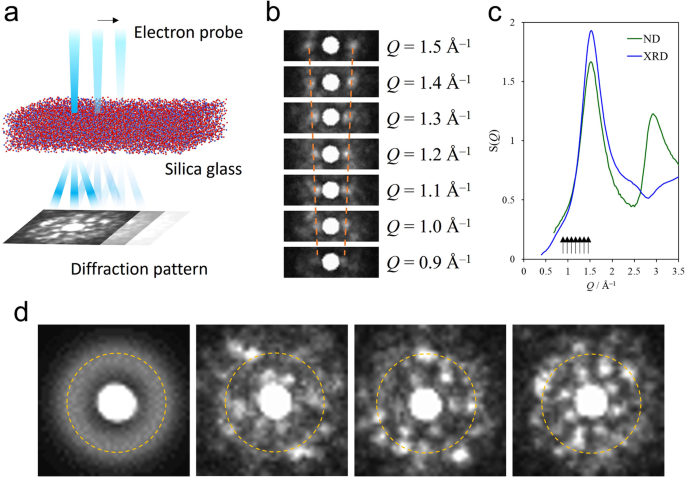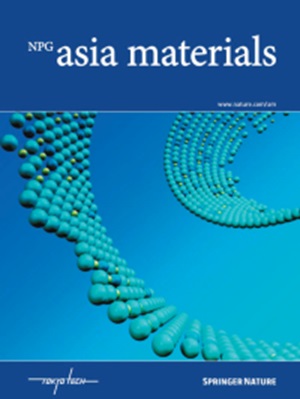Direct observation of the atomic density fluctuation originating from the first sharp diffraction peak in SiO2 glass
IF 8.3
2区 材料科学
Q1 MATERIALS SCIENCE, MULTIDISCIPLINARY
引用次数: 0
Abstract
The intermediate-range order of covalently bonded glasses has been extensively studied in terms of their diffraction peaks observed at low scattering angles; these peaks are called the first sharp diffraction peaks (FSDPs). Although the atomic density fluctuations originating from the quasilattice planes are a critical scientific target, direct experimental observations of these fluctuations are still lacking. Here, we report the direct observation of the atomic density fluctuations in silica glass by energy-filtered angstrom-beam electron diffraction. The correspondence between the local electron diffraction patterns of FSDPs and the atomic configurations constructed based on the X-ray and neutron diffraction results revealed that the local atomic density fluctuations originated from the quasi-periodic alternating arrangements of the columnar chain-like atomic configurations and interstitial tubular voids, as in crystals. We also discovered longer-range fluctuations associated with the shoulder of the FSDP on the low-Q side. The hierarchical fluctuations inherent in materials could aid in the elucidation of their properties and performance. This study reports the direct observation of atomic density fluctuations in silica glass using angstrom-beam electron diffraction. The local atomic fluctuations are found to originate from quasi-periodic arrays of nanoscale columnar atomic configurations and interstitial tubular voids. The present study also reveals longer-range fluctuations associated with the shoulder of the first sharp diffraction peak. These findings may help to understand the properties and performance of materials.


直接观察源自二氧化硅玻璃中第一个尖锐衍射峰的原子密度波动
人们通过在低散射角处观察到的衍射峰,对共价键玻璃的中间阶进行了广泛的研究;这些衍射峰被称为第一尖锐衍射峰(FSDPs)。尽管源于准晶格平面的原子密度波动是一个重要的科学目标,但目前仍缺乏对这些波动的直接实验观测。在此,我们报告了通过能量滤波埃束电子衍射对二氧化硅玻璃中原子密度波动的直接观测。FSDPs的局部电子衍射图案与根据X射线和中子衍射结果构建的原子构型之间的对应关系表明,局部原子密度波动源于柱状链状原子构型和间隙管状空隙的准周期交替排列,就像在晶体中一样。我们还发现了与低 Q 边 FSDP 肩相关的长程波动。材料固有的层次波动有助于阐明其特性和性能。
本文章由计算机程序翻译,如有差异,请以英文原文为准。
求助全文
约1分钟内获得全文
求助全文
来源期刊

Npg Asia Materials
MATERIALS SCIENCE, MULTIDISCIPLINARY-
CiteScore
15.40
自引率
1.00%
发文量
87
审稿时长
2 months
期刊介绍:
NPG Asia Materials is an open access, international journal that publishes peer-reviewed review and primary research articles in the field of materials sciences. The journal has a global outlook and reach, with a base in the Asia-Pacific region to reflect the significant and growing output of materials research from this area. The target audience for NPG Asia Materials is scientists and researchers involved in materials research, covering a wide range of disciplines including physical and chemical sciences, biotechnology, and nanotechnology. The journal particularly welcomes high-quality articles from rapidly advancing areas that bridge the gap between materials science and engineering, as well as the classical disciplines of physics, chemistry, and biology. NPG Asia Materials is abstracted/indexed in Journal Citation Reports/Science Edition Web of Knowledge, Google Scholar, Chemical Abstract Services, Scopus, Ulrichsweb (ProQuest), and Scirus.
 求助内容:
求助内容: 应助结果提醒方式:
应助结果提醒方式:


